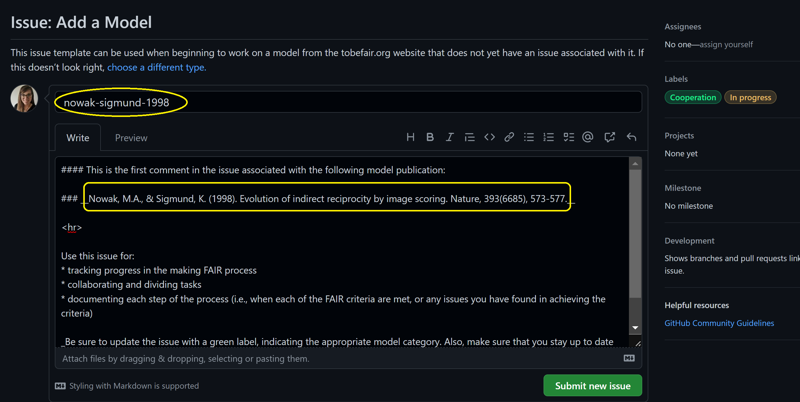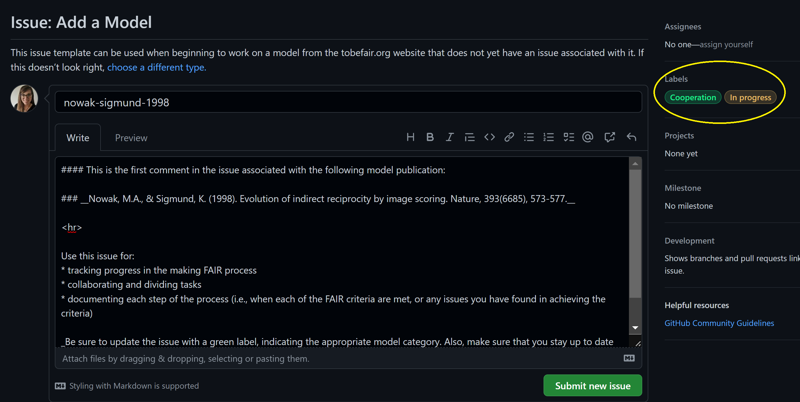Checklist for Getting Started
1. Check out the models currently selected for inclusion in this initiative on the Models page
- On the Models page, you will find links to the four categories of models that have been preliminarily selected for inclusion – Ecological Processes, Land Use, Cooperation, and Crowd Dynamics. Each category has between 20-25 model publications associated with it.
- Each category has a sub-page with a table identifying the initial assessments of each model’s “scores” on the five FAIR criteria, their current status in the making FAIR process (e.g., “Not yet started”, “In progress”), and a link to an associated issue in the GitHub coordination repository if the model is “In progress”.
- Note: a small selection of “Not yet started” models already have Github issue trackers associated with them, to illustrate how the process will look.
2. Identify what you’d like to work on! If you’d prefer to suggest a different model, please refer to our guidance on how to suggest a new model
- Note: for any newly suggested model, you will need to first assess the model publication on the five FAIR criteria.
3. Learn more about how to collaborate using Git and GitHub
- Git is a version control system, or VCS, that tracks the history of changes as people and teams collaborate on projects together. GitHub is an online code hosting platform for version control (using Git) that allows for collaboration on projects from anywhere.
- You will need a GitHub account – and to know some of the basic functionality and terminology of Git/GitHub – to participate in this initiative.
- Check out this step-by-step tutorial to get started, and/or read this introduction from GitHub Docs to dig a bit deeper.
4. For any model you are interested in, create or contribute to an associated issue in the coordination repository
- If there is already an existing issue for the model you’re interested in, there should be a link in the “GitHub Link” column of the table. This issue is where you will track and document progress and collaborate with others.

- If the model has not yet had any contributors, create a new issue by selecting the “Create Issue” button in the table row associated with the model, and a new tab will open with a pre-populated issue template in GitHub.

- Here’s an example issue for the following model citation: Nowak, M.A., & Sigmund, K. (1998). Evolution of indirect reciprocity by image scoring. Nature, 393(6685), 573-577.

5. Write a note in the issue & update the labels
Write a note in the issue to indicate your intention to work on this model, and provide any other relevant details on your anticipated timeline or process for doing so.
- Be sure that the yellow labels are up to date, indicating the status by selecting either (or both) the “In progress” or “Collaborators needed” labels for the issue. To request changes to the yellow labels, make a comment to the issue.
If you have just created an issue, two administrators will be automatically assigned to the issue so that they can create a new repository for this model.
Following from our previous example of the Nowak & Sigmund (1998) model publication, below is a screenshot showing the two labels this issue should have (once work has begun):

6. Get to work!
- You will get a notification on your associated issue that there is a new model repository ready for your use. In the meantime, use the documentation on the Process and How to Make FAIR pages as a checklist.
- Once you have received notification of your new model repository, please follow the instructions and guidelines on the repository’s README file for more information on using GitHub for collaboration (i.e., forking the repository, opening pull requests), the process for making models FAIR, suggestions for the repository file structure, and using the issue tracker for documentation of progress.
Feedback
Was this page helpful?